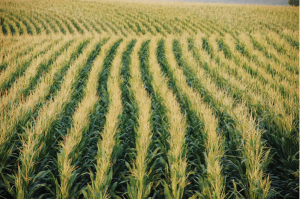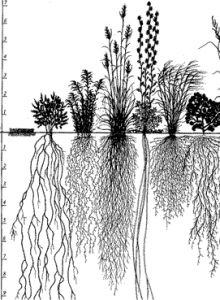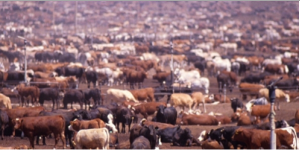The current models of agribusiness and meat production are detrimental to the environment. There is very little profit margin in selling food, so to maximize profit big businesses aim to maximize production. Technological advances and a profit-maximizing mentality have led the industry to adopt harmful practices. Let me give you a brief overview of what I consider to be some of the most pressing issues.
First, in order to maximize their crop yields with minimal effort big agribusinesses utilize synthetic chemical fertilizers. These fertilizers provide the plants with the nutrients they need, but they have two major faults. They convert the soil into an environment that is impossible for certain microorganisms, integral to the health of many plants, to live. The result is a vicious cycle that requires the use of more chemical fertilizer in the growing of future plants. [1]
This may not be so bad if runoff water did not collect the fertilizers as it passes over agricultural land. Through the system of streams and water pathways the runoff eventually end up in large rivers. These rivers dump water full of fertilizer into the ocean. Just as the fertilizer provides nutrients to land plants, it also feeds algae. Huge algal blooms occur in these spots that have high concentrations of fertilizer. When the algae dies and decays it creates hypoxic (low oxygen) zones that are uninhabitable for most living organisms. This can and does destroy entire marine ecosystems as exemplified by the dead zone in the Gulf of Mexico. This dead zone is approximated to cover 5,840 square miles. [2]
Another tool that agribusinesses use to maximize production is monocropping. It can more profitable for farms to produce a lot of one crop rather than lesser amounts of varied crops. This streamlines harvesting and the application of pesticides and fertilizers so that they can be carried out by machinery rather than by hand. Monocropping lowers labor costs, but planting huge fields of genetically similar (or in some instances identical) has its repercussions. This is harmful to biodiversity because it creates a space in which fewer species and varieties of both planted and naturally occurring plants can grow.[3] Rotating plants can replenish the soil of certain nutrients and lessen the need of the synthetic fertilizers that I previously discussed.

(http://aradicle.blogspot.com/2011/05/bitter-flavor-and-bitter-herbs-trust.html)
Monocropping and the lack of biodiversity that it entails make entire farms more vulnerable to pests. Due to the genetic similarity, if one plant is vulnerable to a specific pathogen or insect then so will all the others. This means that if a pest, fungus, or pathogen infects one plant it can easily rip through and kill an entire field of crops. [4]
Different plants’ roots grow to different depths in the soil. Root systems that include varied depths make it more difficult for pests to travel from one plant to the next, so it mitigates the damage a pest can do. Varied depths also limit competition between plants for nutrients in the soil. If they are taking up nutrients from different depths then more is available to each one promoting growth. These are all reasons that polyculture (planting varied crops) produce higher yields and healthier ecosystems.[5]

(http://www.nrcs.usda.gov/wps/portal/nrcs/detail/il/plantsanimals/?cid=nrcs141p2_030726)
The last, and debatably scariest, issue that I want to discuss is actually a problem in meat production, not crop farming. That issue is the prodigious use of antibiotics in raising livestock. An astounding 80% of the antibiotics produced in the U.S. are administered to livestock. This is because the animals are unhealthy. Oftentimes in large meat operations they are kept in overcrowded and filthy conditions. It is also common to feed farm animals feed rather that they are not physiologically equipped to digest. These feeds increase fast weight gain rather than provide animals with nutrients they need to be healthy. Due to the feed and poor living conditions the animals need to be pumped full of antibiotics. As bacteria interacts with antibiotics strains that are only resistant strains remain, and this results in the evolution of more antibiotic resistant bacteria. These bacteria, and antibiotics are often present in the meat that humans consume. The bacteria can be a major health concern for people. Once infected humans have no way to battle antibiotic resistant bacteria. Also, over consumption of antibiotics by people increases the risk of other similar resistant strains developing in and infecting humans directly. [6]

(http://www.sustainabletable.org/859/industrial-livestock-production)
Farm animals in the U.S. produce approximately two trillion tons of waste annually. This waste contains huge amounts of undigested antibiotics and dangerous resistant bacteria. These contents are picked up by runoff water and enter the water cycle. Contaminated water is detrimental to natural processes and organisms, and is eventually consumed by humans. [7]
Though there are many harmful effects of these conventional practices, a trend of smaller sustainable farming is growing. So there is hope! This is easy to see from the statistic, “U.S. sales of organic food and beverages have grown from $1 billion in 1990 to $26.7 billion in 2010.”[8] I will not go into detail, but some examples of increasingly popular and beneficial practices are biodynamic farming, permaculture design, aquaponic systems, polyculture crop rotation, and humanely pasture raising antibiotic-free animals.
[1] http://topics.blogs.nytimes.com/2009/04/14/the-mysteries-of-fertilizer/?_php=true&_type=blogs&_r=0
[2] http://www.nbcnews.com/science/science-news/gulf-mexico-dead-zone-size-connecticut-f6C10798946
[3] http://www.sustainabletable.org/804/industrial-crop-production#Monocropping
[4] http://www.sustainabletable.org/804/industrial-crop-production
[5] http://www.foodforest.com.au/assets/pdfs/analysisfood-garden.pdf
[6] http://www.sustainabletable.org/257/antibiotics
[7] http://www.princeton.edu/~greening/downloads/antibiotic_table_tent1.pdf
[8] http://www.ota.com/organic/mt/business.html

I agree that this is a huge problem with our modern day society. I believe we are making some progress in terms of raising awareness of these issues, through documentaries, books and newspaper articles about GMOs and factory farms, but that being said, I don’t think there is enough information or instruction about how an average person can make a difference. Of course having everyone buy organic crops and meat would be ideal, but they are much more expensive than what is provided in most grocery stores, and that is just not an option for most people. If one can’t afford to switch to organic, is there a way to make an impact on the food business and discourage these unsustainable ways?
I agree with the above comment. I think that the majority of the public recognizes this a a huge problem. The issue facing us now is how to educate the public. We need to come up with ways that the average consumer can make good, sustainable choices. Perhaps if consumers as a whole made changes in purchasing behaviors, producers would have to make subsequent changes in order to deal with the changes in demand.
Another hurdle to this entire issue is cost. Some individuals simply can’t afford to make sustainable food choices because of low incomes. Sometime in the near future, we are going to have to figure out how to make healthy food more affordable because the health costs associated with the diseases that individuals suffering from poor nutrition are rising. Until we are able to do this, producers are going to continue making food as cheaply as possible because when prices are low, more people are able to purchase them.
The complexity of our current food system and its tendency towards agribusiness and consolidation is an emerging issue in society today, and further, one that will be addressed within our generation. You presented a lot of the major problems concerning our current practice. I agree with the other commenters that moving forward and evolving past this will call in an entirely new set of problems.
I think that education on our current practices is the first step towards mobilizing people towards making sustainable change in our current systems. By increasing food literacy, people will at the very least be able to make more informed decisions on where their food is coming from. Another question that was addressed by Hannah was affordability. In almost all cases, organically sourced food will be more expensive than that produced by agribusiness and subsidized by the government. Again, I think that by educating the public and relying heavily on community outreach and engagement efforts, individuals can begin to see some form of tangible change in the food system.
There have community efforts in creating gardens, outreach programs etc that have been notably successful in creating local change. One of these ventures is Will Allen’s Growing Power, a farm and community education center based outside of Milwaukee that has done particularly well in drawing attention our food system and the need for a food movement. I think that drawing upon experience like Allen’s can help similar efforts and create incremental change.
Although I agree whole-heartedly that the livestock production system in the United States does not treat the environment as a valuable and limited resource that should be used responsibly, I would like to point out that this is not solely an American issue. I believe that often times Americans concerned with livestock production view the American food production system as an evil machine that exists nowhere else. However, it is important to note that developing nations and even some highly developed nations such as Germany employ practices in their livestock production similar to those in America. For example, Germany is the second largest exported of pork in the world second only to the United States. This majority of this pork has not been produced sustainably; in fact there is almost no enforceable legislation throughout Germany or the E.U. to force livestock facility operators to comply guidelines regarding animal welfare, just as in the United States.
Despite this trend with pork production, it is also crucial to note that the large-scale beef production that occurs in the heartland is a uniquely American industry among developed nations. European nations have never produced or likely seek to produce the quantity of beef that the United States produces today. This trend can be attributed to the Mad Cow outbreak of the 1980’s and 1990’s that has been said to permanently lower the demand for beef products across Europe. My overarching point here is that although the current food system in the United States is broken and unsustainable, we are not alone in trying to solve this problem. Nations from around the world must openly discuss how to change current agricultural practices if we want future generations to enjoy the same environment we currently do.
Unfortunately, the food culture in the United States only encourages the bad practices you have illustrated in your blog post. I believe that the examples of beneficial practices you provide are certainly important to revolutionize the American farm problems. However, the small and sustainable farmers that utilize much safer and greener practices cannot compete with the big guys of industrial farming. One of the ways that we can create opportunities for these alternatives practices to thrive in the United States is to address the federal government subsidy programs for big farms. We need to address our food industry regulatory power and adjust industry standards. Also, sustainable farming practices are still not affordable for many Americans. So, as a generation focused on redefining the American food culture we need to continue innovating, address federal programs, and most importantly, think ethically about how we can equitably feed a growing population.
I completely agree with Julie. When considering an issue like sustainable farming, it’s important to remember the fact that food production has a direct impact on human well-being. While sustainable farming practices are obviously preferable from an environmental standpoint, there are costs associated with those practices, like higher food prices, than can affect the welfare of American consumers, especially the poor. Furthermore, the process for obtaining designations like “organic” labeling can be incredibly costly. As a result, many local farmers, whose farming practices are more sustainable than large farms, cannot obtain these designations and suffer as a result of the American consumer’s preference for “sustainable” foods.
It’s also interesting to note as well that many designations like “organic” in the United States are not as stringent as many environmentalists would like them to be. In fact, food designated as “organic” can still be produced using pesticides, so long as those pesticides are produced from natural materials. Moreover, there is no guarantee that these “organic” pesticides are any better for humans or the environment than synthetic pesticides (http://blogs.scientificamerican.com/science-sushi/2011/07/18/mythbusting-101-organic-farming-conventional-agriculture/). At the end of the day, much of today’s “sustainable” farming is just greenwashing.